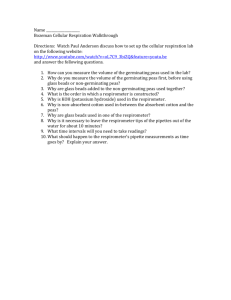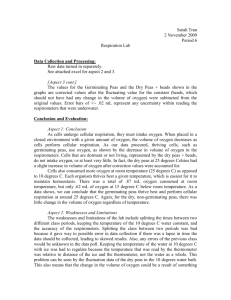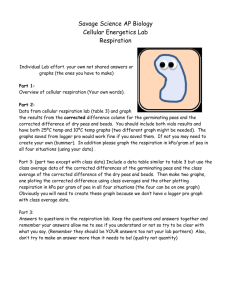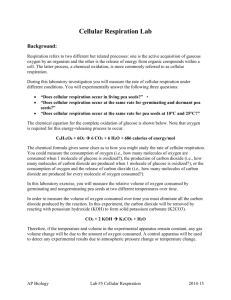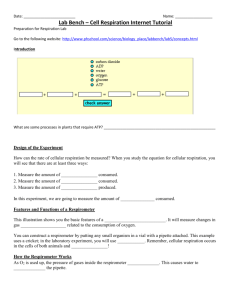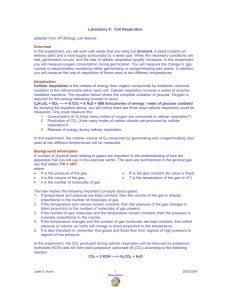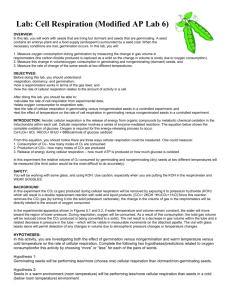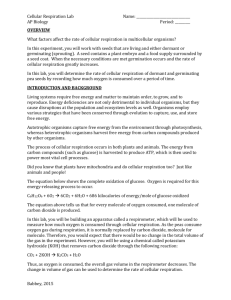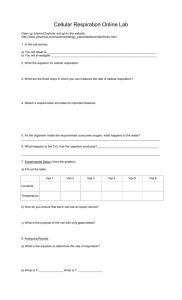Pre-Lab Information: Cell Respiration
advertisement
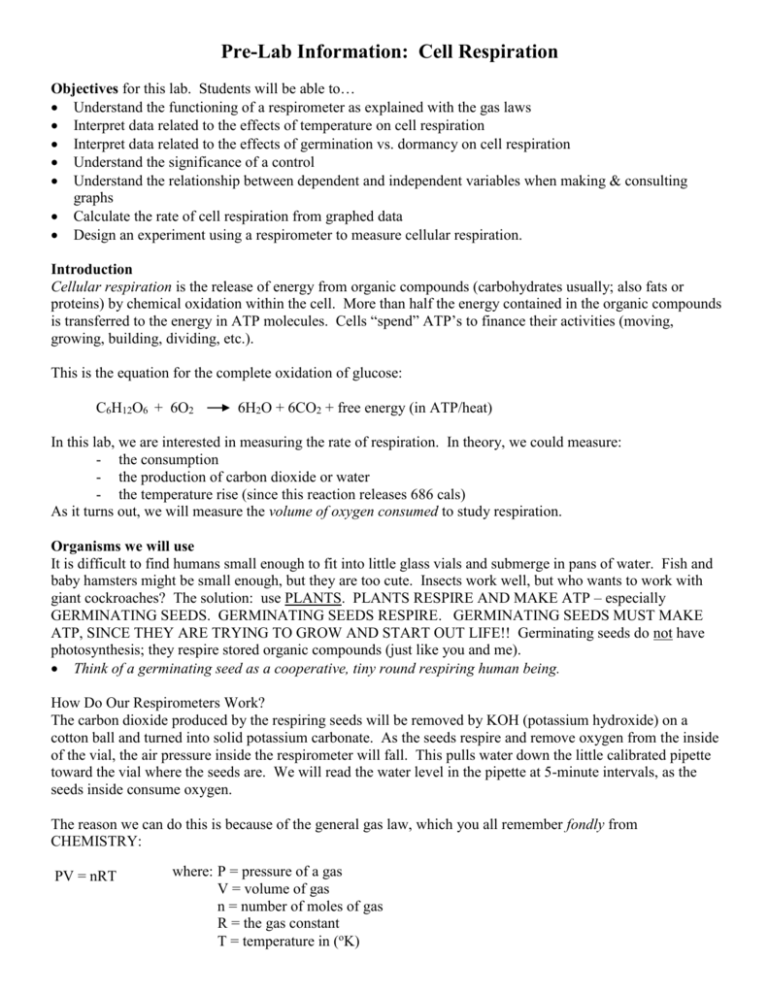
Pre-Lab Information: Cell Respiration Objectives for this lab. Students will be able to… Understand the functioning of a respirometer as explained with the gas laws Interpret data related to the effects of temperature on cell respiration Interpret data related to the effects of germination vs. dormancy on cell respiration Understand the significance of a control Understand the relationship between dependent and independent variables when making & consulting graphs Calculate the rate of cell respiration from graphed data Design an experiment using a respirometer to measure cellular respiration. Introduction Cellular respiration is the release of energy from organic compounds (carbohydrates usually; also fats or proteins) by chemical oxidation within the cell. More than half the energy contained in the organic compounds is transferred to the energy in ATP molecules. Cells “spend” ATP’s to finance their activities (moving, growing, building, dividing, etc.). This is the equation for the complete oxidation of glucose: C6H12O6 + 6O2 6H2O + 6CO2 + free energy (in ATP/heat) In this lab, we are interested in measuring the rate of respiration. In theory, we could measure: - the consumption - the production of carbon dioxide or water - the temperature rise (since this reaction releases 686 cals) As it turns out, we will measure the volume of oxygen consumed to study respiration. Organisms we will use It is difficult to find humans small enough to fit into little glass vials and submerge in pans of water. Fish and baby hamsters might be small enough, but they are too cute. Insects work well, but who wants to work with giant cockroaches? The solution: use PLANTS. PLANTS RESPIRE AND MAKE ATP – especially GERMINATING SEEDS. GERMINATING SEEDS RESPIRE. GERMINATING SEEDS MUST MAKE ATP, SINCE THEY ARE TRYING TO GROW AND START OUT LIFE!! Germinating seeds do not have photosynthesis; they respire stored organic compounds (just like you and me). Think of a germinating seed as a cooperative, tiny round respiring human being. How Do Our Respirometers Work? The carbon dioxide produced by the respiring seeds will be removed by KOH (potassium hydroxide) on a cotton ball and turned into solid potassium carbonate. As the seeds respire and remove oxygen from the inside of the vial, the air pressure inside the respirometer will fall. This pulls water down the little calibrated pipette toward the vial where the seeds are. We will read the water level in the pipette at 5-minute intervals, as the seeds inside consume oxygen. The reason we can do this is because of the general gas law, which you all remember fondly from CHEMISTRY: PV = nRT where: P = pressure of a gas V = volume of gas n = number of moles of gas R = the gas constant T = temperature in (oK) This law implies that if temperature and volume are held constant, pressure of a gas is directly proportional to the number of moles of the gas. The air pressure in the respirometer falls (sucking water in) because oxygen molecules are being consumed. Of course, conditions may change during the course of the experiment (from 8 to 9 am, temperature will rise and air pressure may change, too, depending on the weather) so we set up control respirometers containing glass beads instead of seeds. Making Hypotheses. You will be comparing respiration of germinating seeds (which have been soaked in water) vs. dormant (non-germinating) seeds (dry – out of the package). Which will show a faster respiration rate? respiration of all seeds at room temperature, vs. in a cold (10C) environment. All else being equal, should respiration be faster at room temp or at 10C? You will also be measuring respiration rate (mls oxygen consumed/min). Guess at the respiration rate of germinating seeds. For comparison, a resting person respires at the rate of about 7.5 liters of air each minute; a mouse, .02 liters per minute; How fast does a seed respire? Make a guess – do you think it is one-tenth as fast as a person? one-one thousandth? or do seeds respire fast than we do? Laboratory 5 Cellular Respiration a) Materials, per group water bath 15 dormant peas 100-ml graduate four respirometers glass beads ice (some groups only) 25 germinating peas thermometer 2 crickets weights For respirometer assembly: absorbent cotton, 15% KOH & eyedropper, nonabsorbent cotton, glass vial, stopper with sealed 1-ml serological pipette. b) 1. 2. 3. Procedure Fill the water bath with tap water to allow time for the temperature of the bath to thermally equilibrate. If indicated by your instructor, begin adding ice to your water bath until it reaches 10C. Find the volume of 15 germinating peas by the water displacement method: a. Fill a graduate with 50 ml of water. b. Add the 15 peas and note new water level. c. Subtract (b) – (a) to find the volume of the peas. 4. Remove the germinating peas and set them aside on a paper towel. 5. Refill the graduate with 50 ml of water. Add 15 dormant (dry) peas, then add enough glass beads until you have attainted a volume equivalent to the volume of the germinating peas (measured in #2 above). 6. Remove the dormant peas & beads and set them aside on a paper towel. 7. Refill the graduate with another 50 ml of water. Add glass beads only (no peas) until you have attained a volume equivalent to that of the germinating peas (from #2 above). 8. Remove the beads and set them aside on a paper towel. 9. Assemble three respirometers (see the picture on the pre-lab). In each of 4 vials, add: a. A small wad of absorbent cotton saturated with 15% KOH (use a dropper: don’t get the KOH on the sides of the vial if you help it). b. A small wad of nonabsorbent cotton on top of the absorbent cotton. c. The germinating peas, or the dormant peas & beads, or the beads only, or 2 crickets d. Stopper/pipette assembly (mouth of pipette should not be obstructed in the vial). e. Weight on top of the stopper 10. Make a sling of masking tape over the water bath to hold the pipettes out of the water. 11. Place respirometers tilted into the bath with pipettes out of the water and resting on the sling for a 5 minute equalization period (the exception is the crickets…don’t equalize them or they run out of air) 12. Place respirometers into the water bath and allow to equalize for another 5 minutes then begin recording position of the water in the pipette every 5 minutes for a total of 30. The initial position of the water after equalization is time 0. c) Helpful Figures
